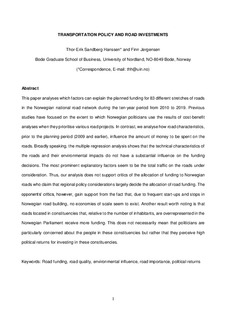Transportation policy and road investments
Journal article, Peer reviewed

Åpne
Permanent lenke
http://hdl.handle.net/11250/284945Utgivelsesdato
2015Metadata
Vis full innførselSamlinger
Originalversjon
Hanssen, T.-E. S. & Jørgensen, F. (2015). Transportation policy and road investments. Transport Policy, 40, 49-57. doi: 10.1016/j.tranpol.2015.02.010 10.1016/j.tranpol.2015.02.010Sammendrag
This paper analyses which factors can explain the planned funding for 83 different stretches of roads in the Norwegian national road network during the ten-year period from 2010 to 2019. Previous studies have focused on the extent to which Norwegian politicians use the results of cost-benefit analyses when they prioritise various road projects. In contrast, we analyse how road characteristics, prior to the planning period (2009 and earlier), influence the amount of money to be spent on the roads. Broadly speaking, the multiple regression analysis shows that the technical characteristics of the roads and their environmental impacts do not have a substantial influence on the funding decisions. The most prominent explanatory factors seem to be the total traffic on the roads under consideration. Thus, our analysis does not support critics of the allocation of funding to Norwegian roads who claim that regional policy considerations largely decide the allocation of road fundings. The opponents` critics, however, gain support from the fact that, due to frequent start-ups and stops in Norwegian road building, no economies of scale seem to exist. Another result worth noting is that roads located in constituencies that, relative to the number of inhabitants, are overrepresented in the Norwegian Parliament receive more funding. This does not necessarily mean that politicians are particularly concerned about the people in these constituencies but rather that they perceive high political returns for investing in these constituencies.